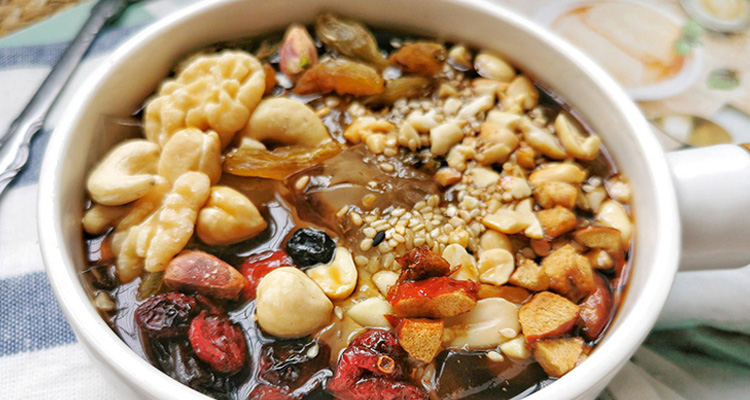Bingfen: Sichuan’s Cooling Summer Dessert
1. A Breathable Bowl of Refreshment: The Story of Bingfen
In summer across southwestern China—especially in Sichuan and Chongqing—locals often reach for something cool after a fiery hotpot or spicy skewers. Bingfen (ice jelly) is the translucent, spoon-trembling dessert that soothes the palate. More than a sweet, it’s a seasonal ritual: a bowl of clear gel topped with sweet syrup and crunchy garnishes that cools you from the inside out.
2. Origins and History: Pengshan’s Riverside Wisdom
Bingfen originated in Pengshan County (now part of Meishan) in Sichuan during the late Ming and early Qing dynasties. A popular local tale tells of a girl who accidentally dropped the fruit of the plant known as Nicandra physalodes (called “jia suan jiang” locally) into a water jar. The water gelled into a clear, jelly-like substance. Curious, she tasted it and found it incredibly refreshing. That simple discovery—using natural plant pectin to create a cooling dessert—spread from Pengshan across the southwest.
Whether the story is fully factual or folktale, it highlights how everyday ingenuity turned a natural gift into a beloved street food. From humble village origins to urban stalls, bingfen retains its reputation for being natural, healthy, and a perfect antidote to heat.

3. Cultural Meaning: A Summer Symphony on Every Street Corner
In Sichuan, Chongqing, Yunnan, and Guizhou, bingfen is more than a snack. It’s woven into daily life. During summer you’ll find carts and small shops selling bingfen from busy shopping streets to hidden alleys. Vendors scoop wobbly, crystal-clear jelly from large tubs, pour dark, glossy brown sugar syrup over it, and sprinkle hawthorn flakes, raisins, crushed peanuts, and fragrant sesame. Watching the vendor assemble a bowl feels like witnessing a quick, comforting ritual. For locals, sharing bingfen with friends is a simple pleasure and a cooling end to a hot day.
4. Ingredients and Preparation: Simple Ingredients, Magical Transformation
The charm of bingfen comes from natural ingredients and a deceptively skilled process:
- Core ingredient — bingfen seeds: The key is the seed of the plant commonly called “jia suan jiang.” These brown seeds contain plant pectin that creates the jelly texture.
- The gel trick — hand rubbing: Traditionally, the seeds are wrapped in cloth and rubbed in cool boiled water to release the pectin. When the water turns slightly viscous, a small amount of clarified lime water (food-grade calcium hydroxide solution) is sometimes added as a natural coagulant. After resting for an hour or two, the liquid sets into a translucent, bouncy jelly. Pre-made bingfen powder exists for convenience, but many purists prefer the slightly bubbly, silkier texture of hand-made bingfen.
- Soul companions — brown sugar syrup and toppings: The jelly itself is mild; the flavor comes from sweet, thick brown sugar syrup and toppings like tart hawthorn pieces, chewy raisins, crunchy crushed peanuts, toasted white sesame, fresh fruit, fermented glutinous rice (laozhao), or even small glutinous rice balls.

5. Flavor and Texture: A Cooling Ballet on the Tongue
Bingfen’s appearance is enticing: amber brown syrup bathing semi-transparent jelly flecked with colorful toppings. When you touch it with a spoon, the jelly trembles and shows its elasticity. The first sensation is clean, chilling refreshment that instantly cuts through summer heat. The jelly dissolves smoothly on the tongue with a delicate, plant-fresh note. The brown sugar brings mellow sweetness, balanced by hawthorn’s tartness, raisins’ chew, and peanuts’ crunch—resulting in a complex but not cloying mix. It’s sweet, refreshing, and leaves a pleasantly clean aftertaste.
6. When to Eat Bingfen: The Perfect Ending to a Spicy Meal
For visitors, bingfen fits several ideal moments:
- After a spicy meal: It’s the classic follow-up to Sichuan or Chongqing hotpot, skewers, or malatang—an excellent “spice neutralizer.”
- Afternoon treat: Swap high-calorie cakes or milk teas for a light, refreshing bingfen on a hot afternoon.
- Street snack: Buy a bowl from a street vendor while exploring local neighborhoods to get a taste of authentic city life.

7. Traveler Tips: How to Enjoy Bingfen Like a Local
- Where to find the most authentic bingfen? Look for busy street stalls or small shops where locals queue—night markets are especially reliable.
- How to choose? Start with the classic version, then try richer or creative variations with fruit, rose syrup, or sticky rice additions.
- Safety and digestion: Traditional bingfen is made from plant gel and is generally gentle on digestion; most people tolerate it well.
- Best season: Bingfen is seasonal—about April through October is prime time.
8. Home Version: Bring Southwestern Coolness Home
If you fall in love with bingfen, you can recreate it abroad. Buy ready-made bingfen powder online and follow these simple steps:
- Boil water, stir in bingfen powder until dissolved, then pour into a container to cool. Chill in the fridge until set (2–3 hours).
- Make brown sugar syrup by simmering brown sugar with water until slightly thick; cool.
- Scoop set jelly into bowls, pour syrup over, and add toppings like fruit cubes and crushed nuts.
This way you can enjoy a taste of southwestern China no matter where you are.

9. Final Thoughts
A humble bowl of bingfen captures natural wonder, folk wisdom, and the warmth of street-level food culture. It’s not a grand feast, but its simple refreshing charm makes it one of the most memorable summer treats across the southwest. When you travel in Sichuan or Chongqing, pause for a bowl—let bingfen glide across your tongue and discover a gentle, cooling side of Chinese cuisine.


